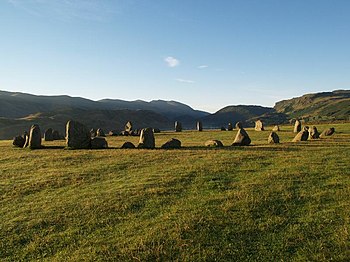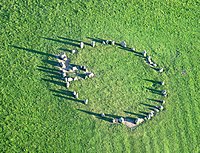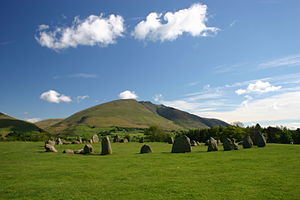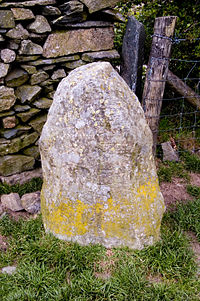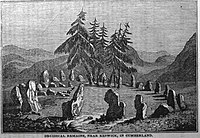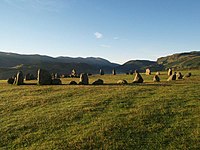Castlerigg Stone Circle
Castlerigg Stone Circle stands atop a low hill at Castlerigg in Cumberland, to the east of Keswick. It is one of the largest of the stone circles of the British Isles and Brittany, which have been numbered at around 1,300 in all.
Different ages have known the circle by different names, amongst them 'Keswick Carles', 'Carles', 'Carsles' or 'Castle-rig'.
Various archaeologists have commented positively on the beauty and romance of the Castlerigg ring and its natural environment. In his study of the stone circles of Cumberland, archaeologist John Waterhouse commented that the site was "one of the most visually impressive prehistoric monuments in Britain."[1]
Every year, thousands of tourists travel to the site, making it the most visited stone circle in the Lake District.[1][2] They stand on a plateau which forms the raised centre of a natural amphitheatre created by the surrounding fells and from within the circle it is possible to see some of the highest peaks in Cumberland: Helvellyn, Skiddaw, Grasmoor and Blencathra.
Contents
Description
The stones are of a local metamorphic slate, set in a flattened circle, measuring 107 feet at its widest and 97 feet at its narrowest. The heaviest stone has been estimated to weigh around 16 tons and the tallest stone measures approximately 8 feet high. There is a gap 11 feet wide in its northern edge, which may have been an entrance.
Within the circle, abutting its eastern quadrant, is a roughly rectangular setting of a further 10 stones.
The circle was probably constructed around 3200 BC (Late Neolithic/Early Bronze-Age), making it one of the earliest stone circles in Britain and possibly in Europe.[3] It is important to archaeoastronomers who have noted that the sunrise during the Autumn equinox appears over the top of Threlkeld Knotts, a hill two miles to the east. Some stones in the circle have been aligned with the midwinter sunrise and various lunar positions.
There is a tradition that it is impossible to count the number of stones within Castlerigg; every attempt will result in a different answer. This tradition, however, may not be far from the truth. Due to erosion of the soil around the stones, caused by the large number of visitors to the monument, several smaller stones have ‘appeared’ next to some of the larger stones. Because these stones are so small, they are likely to have been packing stones used to support the larger stones when the circle was constructed and would originally have been buried. Differences in opinion as to the exact number of stones within Castlerigg are usually down to whether the observer counts these small packing stones, or not; some count 38 and others, 42. The ‘official’ number of stones, as represented on the National Trust information board at the monument, is 40. It is not know whether the teller found the same number when he counted again.
In the early 20th century, a single outlying stone was erected by a farmer approximately 90m to the south west of Castlerigg. This stone has many linear ‘scars’ along its side from being repeatedly struck by a plough, suggesting that it was once buried below the surface and also why the farmer dug it up. It is not possible to say whether this stone was originally part of the circle, or just a naturally deposited boulder.
Archaeological speculation
The original motivation behind the construction of Castlerigg, its subsequent uses and how these may have changed over time are not known. Current thinking has linked Castlerigg with the Neolithic Langdale axe industry in the nearby Langdale fells: the circle may have been a meeting place where these axes were traded or exchanged. Ritually deposited stone axes have been found all over Britain, suggesting that their uses went far beyond their practical capabilities.
Antiquarian study of Castlerigg
Two of Britain's earliest antiquarians, John Aubrey (1626–97) and William Camden (1551–1623), visited Cumberland with an interest in studying the area's megalithic monuments. Both described Long Meg and Her Daughters, another large stone circle, and recounted local legend and folklore associated with this monument, but neither writers mentions a visit to Castlerigg or the area around Keswick.[4] John Aubrey was also the first writer to erroneously connect Neolithic and Bronze-Age megalithic monuments with the Iron-Age Druids.
It was not until the early 18th century that Castlerigg came to the attention of the wider public, when William Stukeley (1687–1765) visited the site, in 1725.
Stukeley’s account of his visit to Castlerigg is brief and was published in his Itinerarium Curiosum[5] in 1776, 11 years after his death. Stukeley’s visit is important, as it is the earliest written record of the stone circle at Castlerigg:
…for a mile before we came to Keswick, on an eminence in the middle of a great concavity of those rude hills, and not far from the banks of the river Greata, I observed another Celtic work, very intire: it is 100 foot in diameter, and consists of forty stones, some very large. At the east end of it is a grave, made of such other stones, in number about ten: this is placed in the very east point of the circle, and within it: there is not a stone wanting, though some are removed a little out of their first station: they call it the Carsles, and, corruptly I suppose, Castle-rig. There seemed to be another larger circle in the next pasture toward the town. (Stukeley 1969 Vol. II, 48).
Stukeley could be describing the circle as it stands today, as it has changed little in the three centuries since his visit. The rectangular enclosure within the circle, that Stukeley took to be a grave, still consists of 10 stones. It is not clear, however, why Stukeley believed the circle was not missing a single stone. Today there are several large gaps in the circle, suggesting that a number of stones may have indeed been either moved into a different position (possibly after the stone had fallen or been removed completely). Of course, there is no certainty today as to the original appearance of the circle, or how much it may have changed in the preceding millennia, prior to Stukeley's visit. It is believed, however, that the circle survives today in a relatively intact state, changed certainly, but not so far from its original design.
Stukeley’s observation of a second circle in the next field is a great revelation that places the stones at Castlerigg in a whole new light; that he fails to deliver a description demonstrates well the frustration felt by modern researchers when dealing with the works of antiquarians. This account could easily be dismissed today as pure fancy or it could be thought that he had mistakenly described a natural feature, as there is no evidence of it today, either above ground or in the observations of later scholars.
The 19th century
The apparently unspoilt and seemingly timeless landscape setting of Castlerigg stone circle provided inspiration for the poets, painters and writers of the 19th century Romantic movement. In John Keats’ Hyperion the passage “Scarce images of life, one here, one there,/Lay vast and edgeways; like a dismal cirque/Of Druid stones, upon a forlorn moor…“ is alleged to have been inspired by his visit to the stones; a visit, it seems, with which he was less than impressed. Samuel Taylor Coleridge, in 1799, visited Castlerigg with William Wordsworth and wrote of it, that a mile and a half from Keswick stands “…a Druidical circle [where] the mountains stand one behind the other, in orderly array as if evoked by and attentive to the assembly of white-vested wizards”.
An early description of Castlerigg stone circle can be found in the 1843 book The Wonders of the World in Nature, Art and Mind, by Robert Sears.[6] In the passage quoted below, Sears also quotes an earlier description of the circle by Ann Radcliffe (Mrs. Radcliffe).
The Druidical Circle, represented in the accompanying plate, is to be found on the summit of a bold and commanding eminence called Castle-Rigg, about a mile and a half on the old road, leading from Keswick, over the hills to Penrith,—a situation so wild, vast, and beautiful, that one cannot, perhaps, find better terms to convey an idea of it than by adopting the language of a celebrated female writer, (Mrs. Radclifle,) who, travelling over the same ground years ago, thus described the scene: "Whether our judgment," she says, " was influenced by the authority of a Druid's choice, or that the place itself commanded the opinion, we thought this situation the most severely grand of any hitherto passed. There is, perhaps, not a single object in the scene that interrupts the solemn tone of feeling impressed by its general character of profound solitude, greatness, and awful wildness. Castle-Rigg is the centre point of three valleys that dart immediately under it from the eye, and whose mountains form part of an amphitheatre, which is completed by those of Borrowdale on the west, and by the precipices of Skiddaw and Saddleback, close on the north. The hue which pervades all these mountains is that of dark heath or rock; they are thrown into every form and direction that fancy would suggest, and are at that distance which allows all their grandeur to prevail. Such seclusion and sublimity were indeed well suited to the dark and wild mysteries of the Druids."
Sears then continues his description:
The one here represented is of the first, or simple class, and consists, at present, of about forty stones of different sizes, all, or most of them, of dark granite,— the highest about seven feet, several about four, and others considerably less ; the few fir-trees in the centre are, of course, of very modern growth. The form may, with more propriety, be called an oval, being thirty-five yards in one direction, and thirty-three yards in another, in which respect it assimilates exactly to that of Rollrich; but what distinguishes this from all other Druidical remains of a similar nature, is the rectangular enclosure on the eastward side of the circle, including a space of about eight feet by four. The object of this is a matter of conjecture ;—by some it is supposed to have been a sort of Holy of Holies where the Druids met, separated from the vulgar, to perform their rites, their divinations, or sit in council to determine controversies ; others consider it to have been for the purposes of burial; probably it might have been intended for both.
The later 19th century saw an increase in research into Castlerigg stone circle. C W Dymond visited the circle in 1878 and 1881, from which visits he produced the first accurate plan of the stones. He marked the position of one of the internal cairns, showing that it was clearly visible at that time, but missed the other two cairns observed by Benjamin Williams[7] in 1856 showing that these two features have never been clearly defined.
The only known archaeological excavation at Castlerigg was carried out by W K Dover in 1882, one year before the site was scheduled. His excavation targeted the internal rectangular enclosure at the eastern side of the circle and his account of his excavation is brief and hidden within details of a day trip to the circle on 5 October 1882, by members of the Cumberland and Westmorland Antiquarian and Archaeological Society, which was published in 1883:[8]
Prior to the visit of the Society some excavations had been made under the superintendence of Mr. W Kinsey Dover, with the view of finding whether the subsoil would disclose anything that might lead to some conclusion as to the age or object of the circle. The following is Mr. Dover’s report: Length of inclosure within the Keswick stone circle, 22 feet, east and west; breadth, 11 feet, north and south. Length opened out, 18 feet to 19 feet; breadth, 3 feet 3 inches, with two cross cuts of about 2 feet. Depth of dark superficial soil to where the yellow undisturbed soil appears, 14 inches, with the exception of a small portion at the west end where the black soil mixed with stones continued to a depth of 3 feet. Near the bottom here, I found what I think to be a few small pieces of burned wood or charcoal, also some dark unctuous sort of earth, a sample of both I brought away. (Dover 1883, 505).
What subsequently happened to the samples of ‘burned wood or charcoal’ and the ‘dark unctuous sort of earth’ is unknown, other than they are now likely to be lost or, if not, too contaminated to be worth modern scientific analysis. Nevertheless, Dover's excavation is the only one to have been carried out at Castlerigg. It is, however, believed by some,[9] based on the dimensions given by Dover, that if any stratigraphy exists within the rectangular enclosure it would not have been completely destroyed and the potential to create a relative sequence between the circle and the enclosure should still be possible. It is unlikely that further excavation around the stones would be permitted today as it is neither threatened by farming or development and erosion of the ground surface by the many visitors to the site is kept in check and is not sufficient to affect the integrity of the stones.
Recent research
Much of our knowledge and understanding of Castlerigg stone circle has been passed down to us by the work of 18th century antiquarians and 19th century amateurs. Considering that the stone circles of Cumberland in general are of such antiquity, being the earliest stone circles in the whole of Europe, it is surprising that so little work has been carried out here under modern conditions and that none of the stone circles of the Lake Counties have so far been scientifically dated.[10]
English Heritage subjected the scheduled area and the field to its immediate west to a geophysical survey in 1985 in order to improve understanding of the stone circle and to provide a better interpretation for visitors.[11] A full report of the findings from 1985 has still to be published.
Conservation history
Castlerigg stone circle was one of the monuments included in the Ancient Monuments Protection Act 1882, which included a 'Schedule' of 68 sites in Great Britain and Ireland. It thus became one of the first scheduled ancient monuments. The following year the stone circle was 'taken in to state care'.[12] Under the 1882 act a deed of guardianship could be entered into by a landowner, in which the monument, but not the land it stands on, becomes the property of the state. As one of the first such sites to enter into such an agreement it occupies a small place in the history of archaeological conservation.[10] In 1913, Canon Hardwicke Rawnsley, one of the founders of the National Trust, was among the prime organisers of a public subscription which bought the field in which the stone circle stands, which he then donated to the National Trust.[9] Responsibility for the stone circle remains with English Heritage, the successor body to the Ministry of Works, whilst ownership of the site is retained by the National Trust.
Outside links
| ("Wikimedia Commons" has material about Castlerigg Stone Circle) |
- Location map: 54°36’9"N, 3°5’51"W
- Streetmap: NY292236
- Castlerigg Stone Circle - English Heritage
- Castlerigg - mysteriousbritain.co.uk
- Lots of pictures of Castlerigg Stone Circle
- Castlerigg - stonepages.com
- Lake District Walks - Castlerigg Stone Circle
References
- ↑ 1.0 1.1 Waterhouse 1985. p. 43.
- ↑ Díaz-Andreu et al 2006, 1580.
- ↑ Burl, A (2005) A Guide to the Stone Circles of Britain, Ireland and Brittany. London: Yale University.
- ↑ Hayman, R (1997) Riddles in Stone: Myths, Archaeology, and the Ancient Britons. Rio Grande, OH: Hambledon Press.
- ↑ Stukeley, W (1969 (first published 1776)) Itinerarium Curiosum: or, An Account of the Antiquities, and Remarkable Curiosities in Nature or Art, Observed in Travels through Great Britain, Vol. II. Farnborough: Gregg International Publishers Limited.
- ↑ The Wonders of the World in Nature, Art and Mind, Google books.
- ↑ Williams, B (1856) ‘On Some Ancient Monuments in the County of Cumberland and its Borders’ Proceedings of the Society of Antiquaries of London Vol 3, 224-227.
- ↑ Dover, W K (1883) TCWAAS VI, 505.
- ↑ 9.0 9.1 Fraser, D. Howard-Davis, C. Winchester, V. and David, A. (nd) Castlerigg Stone Circle Documentary and Field Survey. Unpublished draft paper.
- ↑ 10.0 10.1 Hodgson, J and Brennand, M (eds.) (2004) North West Region Archaeological Research Framework Prehistoric Resource Assessment Draft, November 2004.
- ↑ David, A (1986) Castlerigg Stone Circle: Preliminary Report on Geophysical Survey, 1985. Ancient Monuments Laboratory.
- ↑ Landscape Britain - extract from Record of scheduled Monuments, accessed 9 July 2014
Books
- Burl, Aubrey (1979). Rings of Stone. London: Francis Lincoln.
- Burl, Aubrey (2000). The Stone Circles of Britain, Ireland and Brittany. New Haven and London: Yale University Press. ISBN 978-0-300-08347-7.
- Burl, Aubrey (2005). A Guide to the Stone Circles of Britain, Ireland and Brittany. New Haven and London: Yale University Press.
- Bradley, Richard (1998). The Significance of Monuments: On the Shaping of Human Experience in Neolithic and Bronze Age Europe. London: Routledge. ISBN 978-0-415-15204-4.
- Clare, Tom (2007). Prehistoric Monuments of the Lake District. Stroud: Tempus. ISBN 978-0-7524-4105-4.
- Waterhouse, John (1985). The Stone Circles of Cumbria. Chichester: Phillimore.
Further reading
- Burl, A (2005) A Guide to the Stone Circles of Britain, Ireland and Brittany. London: Yale University.
- Díaz-Andreu, M. Brooke, C. Rainsbury, M. and Rosser, N. (2006) ‘The Spiral that Vanished: The Application of Non-Contact Recording Techniques to an Elusive Rock Art Motif at Castlerigg Stone Circle in Cumbria’, The Journal of Archaeological Science 33, 1580-1587.
- Dover, W. K. (1883) in ‘Excursions and Proceedings: Thursday and Friday, October 5th and 6th’ TCWAAS VI, 505.
- Dyer, J, Discovering Prehistoric England, Shire, 2001
- Fraser, D. Howard-Davis, C. Winchester, V. and David, A. (nd) Castlerigg Stone Circle Documentary and Field Survey. Unpublished draft paper.
- Hodgson, J and Brennand, M (eds.) (2004) North West Region Archaeological Research Framework Prehistoric Resource Assessment Draft, November 2004.
- Michell, J (1982) Megalithomania: Artists, Antiquarians, and Archaeologists at the Old Stone Monuments. London: Thames and Hudson.
- Stukeley, W (1969 [1776]) Itinerarium Curiosum: or, An Account of the Antiquities, and Remarkable Curiosities in Nature or Art, Observed in Travels through Great Britain, Vol. I. Farnborough: Gregg International Publishers Limited.
- Thom, A. Thom, A. S. and Burl, A. (1980) Megalithic Rings: Plans and Data for 229 Monuments in Britain, BAR British Series 81. Oxford: British Archaeological Reports.
- Trinks, I, Díaz-Andreu, M, Hobbs, R and Sharpe, K E (2005) ‘Digital Rock Art Recording: Visualising Petroglyphs Using 3D Laser Scanner Data’, Rock Art Research 22 (2), 131-139.
- Wood, JE, Sun Moon and Standing Stones, Oxford, 1980
